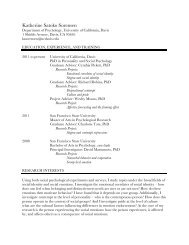The Psychology of Creativity:
The Psychology of Creativity:
The Psychology of Creativity:
Create successful ePaper yourself
Turn your PDF publications into a flip-book with our unique Google optimized e-Paper software.
History <strong>of</strong> <strong>Creativity</strong> Research 16<br />
characteristics that are strongly correlated with creative behavior. <strong>The</strong>se personality assessments are <strong>of</strong> three kinds.<br />
First, the assessment may simply depend on already established scales <strong>of</strong> standard tests, such as the Minnesota<br />
Multiphasic Personality Inventory or Eysenck’s Personality Questionnaire (e.g., Barron, 1969; Cattell & Butcher,<br />
1968; Eysenck, 1993). Second, the assessment may be based on the construction <strong>of</strong> a specialized subscale <strong>of</strong> an<br />
already established personality test. For instance, Gough (1979) devised a Creative Personality Scale from his more<br />
general Adjective Check List. Third, the assessment may rely on a measure that is specially constructed to gauge<br />
individual differences in creative personality. An example is the How Do You Think questionnaire that gauges<br />
whether a person has the interests, values, energy, self-confidence, humor, flexibility, playfulness,<br />
unconventionality, and openness associated with creativity (Davis, 1976).<br />
An alternative approach dates back to Galton’s (1874) study <strong>of</strong> eminent scientists: the biographical<br />
inventory. This technique is predicated on the assumption that creative potential emerges by means <strong>of</strong> a particular<br />
set <strong>of</strong> developmental experiences. <strong>The</strong>se experiences may either reflect genetic predilections (nature) or acquired<br />
inclinations (nurture). For example, Schaefer and Anastasi (1968) designed a biographical inventory that identifies<br />
creativity in adolescent boys. <strong>The</strong> items tap such factors as family background, school activities, and extracurricular<br />
interests. Moreover, the inventory discriminates not only creative from non-creative adolescents but also between<br />
scientific and artistic creativity.<br />
I hasten to that psychologists do not have to confine themselves to a single type <strong>of</strong> psychometric<br />
instrument. On the contrary, many researchers administer whole test batteries in order to investigate the creative<br />
person from as many different angles as possible. For instance, Roe (1953) examined 64 eminent scientists by<br />
having them take a large variety <strong>of</strong> different tests, including cognitive, personality, and biographical assessments.<br />
Another example is the research carried out at the Institute for Personality Assessment and Research (IPAR) at the<br />
University <strong>of</strong> California at Berkeley (Helson, 1999). Here distinguished architects, writers, and other creators were<br />
subjected to extensive and intensive psychometric assessments, yielding major insights into the complexities <strong>of</strong> the<br />
creative personality (e.g., Barron, 1963; MacKinnon, 1978).<br />
Historiometrics. Because this method dates back to Quételet’s (1835/1968) inquiry, it can be considered<br />
the oldest quantitative approach in the study <strong>of</strong> creativity. Even so, it was very slow to develop. In the century<br />
since Quételet’s work, the number <strong>of</strong> significant historiometric investigations can be counted on one hand (viz.,<br />
Cox, 1926; Galton, 1869; Raskin, 1936). <strong>The</strong> methodology did not provide the basis for an entire research program
















